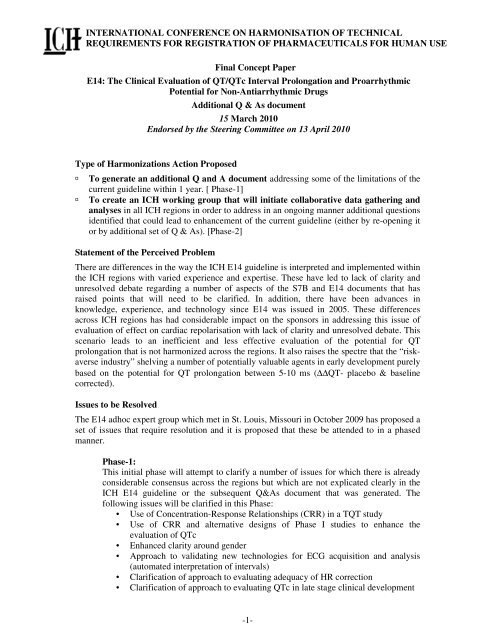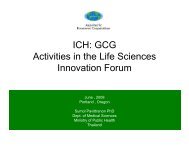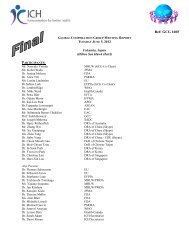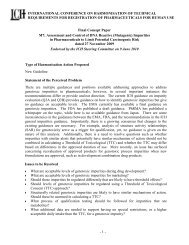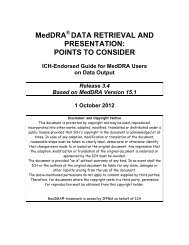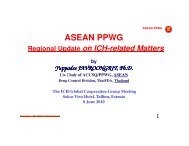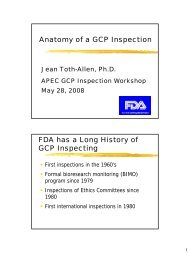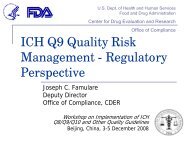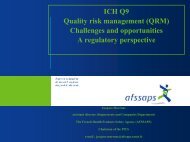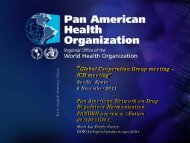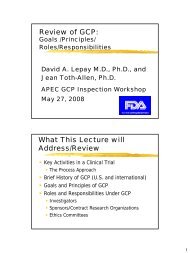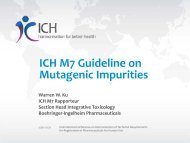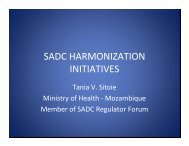Concept Paper - ICH
Concept Paper - ICH
Concept Paper - ICH
You also want an ePaper? Increase the reach of your titles
YUMPU automatically turns print PDFs into web optimized ePapers that Google loves.
INTERNATIONAL CONFERENCE ON HARMONISATION OF TECHNICAL<br />
REQUIREMENTS FOR REGISTRATION OF PHARMACEUTICALS FOR HUMAN USE<br />
Final <strong>Concept</strong> <strong>Paper</strong><br />
E14: The Clinical Evaluation of QT/QTc Interval Prolongation and Proarrhythmic<br />
Potential for Non-Antiarrhythmic Drugs<br />
Additional Q & As document<br />
15 March 2010<br />
Endorsed by the Steering Committee on 13 April 2010<br />
Type of Harmonizations Action Proposed<br />
<br />
<br />
To generate an additional Q and A document addressing some of the limitations of the<br />
current guideline within 1 year. [ Phase-1]<br />
To create an <strong>ICH</strong> working group that will initiate collaborative data gathering and<br />
analyses in all <strong>ICH</strong> regions in order to address in an ongoing manner additional questions<br />
identified that could lead to enhancement of the current guideline (either by re-opening it<br />
or by additional set of Q & As). [Phase-2]<br />
Statement of the Perceived Problem<br />
There are differences in the way the <strong>ICH</strong> E14 guideline is interpreted and implemented within<br />
the <strong>ICH</strong> regions with varied experience and expertise. These have led to lack of clarity and<br />
unresolved debate regarding a number of aspects of the S7B and E14 documents that has<br />
raised points that will need to be clarified. In addition, there have been advances in<br />
knowledge, experience, and technology since E14 was issued in 2005. These differences<br />
across <strong>ICH</strong> regions has had considerable impact on the sponsors in addressing this issue of<br />
evaluation of effect on cardiac repolarisation with lack of clarity and unresolved debate. This<br />
scenario leads to an inefficient and less effective evaluation of the potential for QT<br />
prolongation that is not harmonized across the regions. It also raises the spectre that the “riskaverse<br />
industry” shelving a number of potentially valuable agents in early development purely<br />
based on the potential for QT prolongation between 5-10 ms (∆∆QT- placebo & baseline<br />
corrected).<br />
Issues to be Resolved<br />
The E14 adhoc expert group which met in St. Louis, Missouri in October 2009 has proposed a<br />
set of issues that require resolution and it is proposed that these be attended to in a phased<br />
manner.<br />
Phase-1:<br />
This initial phase will attempt to clarify a number of issues for which there is already<br />
considerable consensus across the regions but which are not explicated clearly in the<br />
<strong>ICH</strong> E14 guideline or the subsequent Q&As document that was generated. The<br />
following issues will be clarified in this Phase:<br />
• Use of Concentration-Response Relationships (CRR) in a TQT study<br />
• Use of CRR and alternative designs of Phase I studies to enhance the<br />
evaluation of QTc<br />
• Enhanced clarity around gender<br />
• Approach to validating new technologies for ECG acquisition and analysis<br />
(automated interpretation of intervals)<br />
• Clarification of approach to evaluating adequacy of HR correction<br />
• Clarification of approach to evaluating QTc in late stage clinical development<br />
-1-
Final E14 Q&A <strong>Concept</strong> <strong>Paper</strong> Endorsed 13 April 2010<br />
Phase-2:<br />
The second Phase of this working group will address several fundamental issues and<br />
questions (listed below) that, if resolved, would require a substantial revision of <strong>ICH</strong><br />
E14. At the present time, however, a productive discussion of these issues requires<br />
additional data collection and discussion. The following issues and questions have<br />
been identified and are proposed to be addressed by the working group in a 1-3 year<br />
time frame.<br />
• Evaluate alternative statistical methods for analyzing continuous QTc data?<br />
• What data and quality control metrics would provide sufficient confidence in<br />
the TQT study to remove the requirement for a positive control? What<br />
alternative positive controls are acceptable and how should they be evaluated?<br />
• Are there important differences in QTc responses across different ethnic<br />
groups?<br />
• Does the preclinical evaluation (S7B) of QT risk reflect the outcome of the<br />
TQT study?<br />
• Can we enhance the preclinical evaluation (S7B) of QTc and gain greater<br />
confidence that a TQT study is not necessary?<br />
• How well can existing and enhanced Phase I data predict a negative TQT<br />
study? (e.g., Can a clearly defined PK-QTc relationship in Phase I at supratherapeutic<br />
exposures exclude the need for a TQT study?)<br />
• Can we identify methods of integrating Phase I data in the context of the S7B<br />
evaluation that would provide sufficient confidence to exclude the need for a<br />
TQT study?<br />
Background to the Proposal<br />
The <strong>ICH</strong> E14 guidance provides recommendations to sponsors concerning the design,<br />
conduct, analysis, and interpretation of clinical studies to assess the potential of a drug to<br />
delay cardiac repolarization. This assessment should include testing the effects of new agents<br />
on the QT/QTc interval as well as the collection of cardiovascular adverse events. The<br />
investigational approach used for a particular drug should be individualized, depending on the<br />
pharmacodynamic, pharmacokinetic, and safety characteristics of the product, as well as on<br />
its proposed clinical use.<br />
E14 was signed off as a Step 4 document in May 2005. At the time of sign-off, it was<br />
recognized that this document would require maintenance as the science evolved over time.<br />
Since 2005, a number of advances relating to knowledge, understanding of the hERG channel<br />
blockade, hERG channel traffic inhibition, potential utility of concentration-QT effect<br />
relationship in the TQT study. The concentration-effect (QT/QTc) relationship has been<br />
explored in phase-I studies during drug development and the statisitical methodolgies utilized<br />
have also improved. Facilities for analyses of QT/QTc intervals from continous recording<br />
over time, offer a unique and more advanced understanding of the QT dynamics in preference<br />
to that of analyzing the QT interval at timed intervals. The statistical methodologies for<br />
analysis of both TQT studies and continous QT data are progressing, but these not been<br />
systematically analysed in the context of regulatory submissions with E14 providing little<br />
opportunity. These advances in experience, and technology will need to be incorporated and<br />
reflected in the guidance document with out being either restrictive or prescriptive. It is<br />
therefore proposed that the working group evaluate these in order to enhance the existing<br />
guidance.<br />
-2-
Final E14 Q&A <strong>Concept</strong> <strong>Paper</strong> Endorsed 13 April 2010<br />
At the <strong>ICH</strong> Steering Committee meeting held in Yokohama on June 6-11, 2009, the Steering<br />
Committee endorsed the establishment of an Informal E14 Discussion Group to assess the<br />
E14 guideline in view of experience gained. The SC disbanded the E14 IWG and requested<br />
the Secretariat to close the E14 mail box; and agreed to the organization of an Informal<br />
Discussion Group in St. Louis, Missouri, October 2009. The <strong>ICH</strong> E14 Informal Discussion<br />
Group met for three days in St. Louis and discussed the status of the implementation of <strong>ICH</strong><br />
E14 in the different regions. The different levels of implementation of <strong>ICH</strong> E14 resulted in<br />
significant differences in experience, data collection, research activity, and expertise across<br />
the regions with regard to issues related to QT/QTc. The group recognized that there have<br />
been significant advances in knowledge, experience, and technology since E14 was issued in<br />
2005.<br />
Type of Expert Working Group and Resources<br />
Based on the proposal to evaluate the proarrhythmic risk in accordance to existing guidance<br />
for both pre-clinical (S7B) and clinical aspects (E14), it is proposed that an Implementation<br />
Working Group (IWG) be set up to advance the work anticipated to resolve the issues. In<br />
order to limit the size of the IWG and based on the <strong>ICH</strong> SC recommendations, the IWG will<br />
be composed primarily of clinical members who will interact ex-committee with their<br />
preclinical safety colleagues in the region and inform the IWG of their deliberations.<br />
However, given the translational aspects of one of the questions (related to the use of PK-PD<br />
modelling) members representing the preclinical sciences with an expertise on PK-PD<br />
modelling will be encouraged to participate in the IWG.<br />
Constitution of the group<br />
While the representation from each <strong>ICH</strong> region is dependent on the regional authorities<br />
wishes and their choice, the current <strong>ICH</strong> E14 Informal Discussion Group (constituated of the<br />
six <strong>ICH</strong> parties and the Observers) has the advantage and experience of working together in<br />
order to effectively arrive at a consensus opinion and produce the expected output. We<br />
therefore request that this group form the basis of the Informal Discussion Group with<br />
recruitment of additional expertise as necessary.<br />
Timing<br />
The anticipated time scale is as follows;<br />
Phase -1<br />
1. <strong>Concept</strong> paper Spring 2010 (anticipated <strong>Concept</strong> paper adoption by<br />
<strong>ICH</strong> SC)<br />
2. Draft Q & As for Phase-1 Jun 2010 (Face to face at <strong>ICH</strong> mtg in Tallinn, Estonia)<br />
3. Finalise Phase-1 Q & As Nov 2010 (Face to face if necessary in Japan)<br />
Phase -2<br />
Other questions will need additional work and might lead to a revision of the E14 Guideline.<br />
It includes discussion of alternative statistical methods for analyzing QTc data, alternative<br />
positive controls, pre-clinical evaluation (S7B) to reflect the outcome of TQT study. Those<br />
efforts should result in an enhanced evaluation of QT in drug development and further<br />
improvement of harmonization across the regions. Based on feedback from the <strong>ICH</strong> SC, The<br />
IWG will develop an additional <strong>Concept</strong> <strong>Paper</strong> for future activities for SC discussion once<br />
Q&As will have progressed.<br />
-3-


